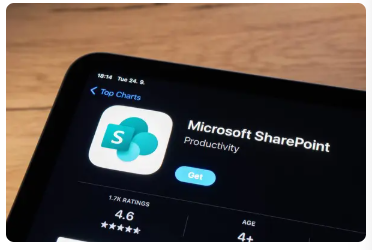In an age where collaboration, transparency, and agility are essential for delivering business value, Microsoft SharePoint stands as a mature and versatile platform that empowers teams to work smarter, not harder. When deployed thoughtfully, SharePoint’s out-of-the-box (OOB) capabilities can become a powerful hub for cross-functional coordination, project tracking, and centralized knowledge management. This post explores how SharePoint Lists and Custom Views, along with Microsoft’s guidance on design and integration, can elevate enterprise collaboration. We also explore how SharePoint naturally complements the broader Microsoft Power Platform ecosystem.
Leveraging SharePoint Lists and Custom Views
One of SharePoint’s most robust and accessible features is the SharePoint List. Lists are essentially dynamic, customizable tables that can track everything from tasks and issues to project milestones and asset inventories.
Key Benefits of SharePoint Lists:
- No-code customization: Product managers and business analysts can configure list columns, validation rules, and views without developer involvement.
- Versioning and history tracking: Track changes over time and ensure auditability.
- Integration with Power Automate: Trigger notifications, approvals, and workflows seamlessly.
- Permissions and roles: Manage access at the list or item level.
Custom Views for Tracking and Visibility
Custom Views allow teams to tailor the display of data based on filters, grouping, and formatting. For example:
- Kanban-style board views for task management
- Calendar views for project planning
- Gantt chart-style views (via integration)
- Conditional formatting for flagging overdue tasks or priority items
These tools empower cross-functional teams to stay aligned while reducing overhead and friction in status reporting.
Microsoft Style Guide and Look Book for Site Design
Microsoft provides a robust Style Guide and the SharePoint Look Book to ensure visual consistency and brand alignment across SharePoint experiences. These resources are invaluable for teams aiming to build purposeful and aesthetically aligned sites without extensive design resources.
Site Templates Include:
- Team Sites: Best suited for departmental and agile teams with shared document libraries, task lists, and communication threads.
- Communication Sites: Ideal for broadcasting information broadly across the organization, such as leadership updates or program overviews.
- Project Management Sites: Purpose-built for managing scope, timelines, resources, and risks, often integrated with Planner and Microsoft Project.
These templates align with best practices for UX and accessibility, enabling teams to create visually polished experiences with minimal customization.
SharePoint in the Power Platform Ecosystem
SharePoint is not an isolated tool; it is a strategic component of the broader Microsoft Power Platform, which includes:
- Power Apps: Build tailored applications that write to and read from SharePoint Lists.
- Power Automate: Automate tasks like notifications, document approvals, or reminders based on list activity.
- Power BI: Visualize list data to create dashboards and reports for operational insights.
Together, these tools allow organizations to move beyond static document repositories and into the realm of data-driven collaboration. With low-code capabilities, technical leads and business users alike can prototype, deploy, and iterate on solutions that enhance team productivity.
Governance and Strategic Alignment
For leadership and technical governance teams, aligning SharePoint implementations with organizational strategy is paramount. SharePoint allows for scalable governance models, including:
- Information architecture standardization
- Security and compliance controls
- Site provisioning automation
- Template reuse for onboarding and project kickoff
When well-structured, SharePoint supports federated team environments while enabling centralized oversight.
Conclusion
SharePoint’s out-of-the-box features, especially Lists and Custom Views, are more than functional conveniences—they are foundational tools for building transparency, collaboration, and accountability across teams. When coupled with Microsoft’s design guidance and integrated with the Power Platform, SharePoint becomes a comprehensive solution for modern work management.
Recommendation for Product Managers and Technical Leads: Start by evaluating where manual coordination or siloed communication exists. A well-configured SharePoint site could be the bridge that brings data, people, and process together into a shared, governed space.
With the right implementation, SharePoint can be a catalyst for operational excellence and digital transformation.

